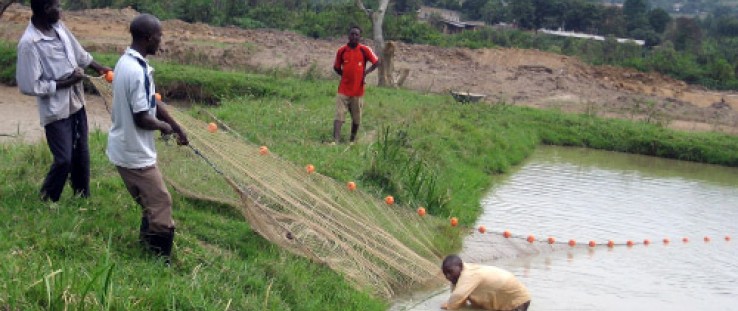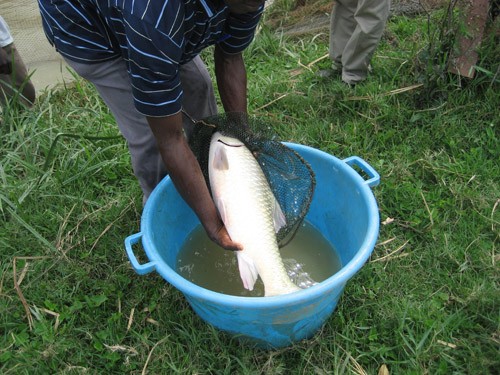 Ugandan fish farmers harvest carp from an aquaculture pond.
Cheryl L. Wojciechowski/USAID
Ugandan fish farmers harvest carp from an aquaculture pond.
Cheryl L. Wojciechowski/USAID
 Ugandan fish farmers harvest carp from an aquaculture pond.
Cheryl L. Wojciechowski/USAID
Ugandan fish farmers harvest carp from an aquaculture pond.
Cheryl L. Wojciechowski/USAID
Justus Rutaisire of Uganda's Makerere University is reversing the decline of Uganda's aquaculture industry.
Once teeming with native carp, the African Great Lakes provided jobs and a source of protein to residents. Overfishing and the introduction of non-native fish for the past 60 years have devastated the carp population, causing a collapse of fisheries and a near disappearance of carp from their former habitats.
After the USAID-funded Uganda carp project began producing solid technical results, the World Bank Millennium Science Initiative awarded the researchers a $770,000 grant in late 2007, acknowledging the initial effort's widespread impact and success. Of 160 submitted proposals, only 12 were selected for funding.
For this new effort, researchers are focusing on the Nile perch. While Nile perch is a predator of carp in the Great Lakes, it has become a principal export of Uganda, Kenya, and Tanzania.
The perch is a voracious feeder and can reach 400 pounds; making it too large to be caught by local fishermen in their boats. With the depletion of the smaller fish in the lakes, the Nile perch has no food source and are themselves becoming depleted.
Researchers are now working to find better ways to culture the Nile perch in man-made ponds away from the lakes, thus helping to boost Uganda's fish export industry as well as the nutrition of the local population.
In an effort to provide jobs and a source of protein to the most people, Rutaisire, head of aquaculture research at Makerere, collaborated with Israeli researchers to find a way to sustainably produce the locally preferred fish at a distance from the lakes in small ponds run by village farms in Western Uganda. The answer, according to research supported by USAID's Cooperative Development Research (CDR) Program, a joint effort between Israeli and developing country scientists, was aquaculture, which involves raising the carp in a controlled environment in the small farm ponds.
The research team found that the fish could be induced to spawn by simply adjusting the water flow where they lived. After perfecting this technique, researchers taught Ugandan fish farmers how to induce spawning under the country's particular climatic conditions. Over four years, the research team developed robust technologies for induced spawning, reproduction, and growth.
There's Always a Catch
But there was a catch—these techniques required that the carp consume specialized feed for proper larval-stage development. And it was unavailable in Uganda.
Researchers contacted an Israeli feed company that produces a high-quality larval fish feed for help. The feed is now used in Ugandan fish farms and aquaculture centers to support rapid larval growth. Moreover, by the conclusion of the research effort, the technology to manufacture the majority of the fish feed, which is used after the early larval growth stage, was transferred to private Ugandan industries and is now produced locally.
The researchers cite the United Nations Food and Agriculture Organization's estimation that 40 million tons of aquatic food will be needed to feed the world's population in 2030. Sub-Saharan Africa is the only region in the world where fish consumption is falling. By improving the ability to produce carp and other fish in ponds away from the environmentally stressed African Great Lakes, the research serves to address food security in Uganda.
Using the same techniques as with carp, the team also improved aquaculture techniques related to spawning of fish such as the Nile tilapia and African catfish, which are already being farmed in ponds by Ugandans. The success of their USAID-CDR project helped them win a new $770,000 grant from the World Bank's Millennium Science Initiative to adapt the Nile perch to aquaculture as well (see sidebar).
Although Rutaisire accomplished his research goals, his impact on development in aquaculture continues.
"This project demonstrates how a $200,000 research grant can lead to significant development impact, build local technical capacity, and catalyze new partnerships with the public and private sectors," observed David O'Brien, the CDR program manager.
Now Uganda has four large fish farms that produce enough fingerlings to populate hundreds of small village ponds, providing high-protein food to the local populace. Technology transfer of fish feed production and aquaculture has also provided jobs and increased income to farmers.










Comment
Make a general inquiry or suggest an improvement.